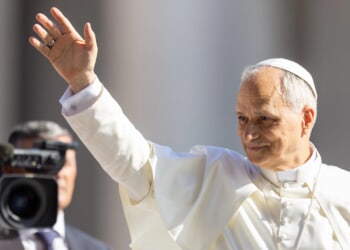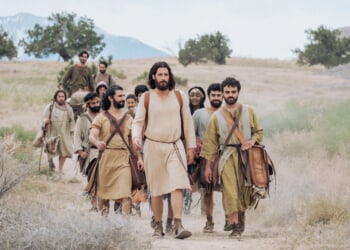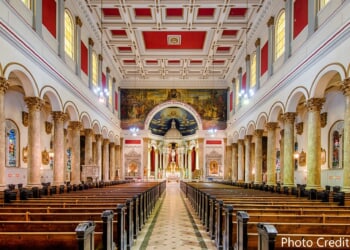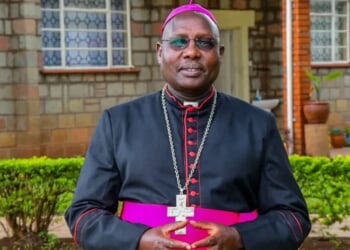Vatican City, Jul 28, 2025 /
13:09 pm
The Vatican welcomes more than a thousand social media influencers to Rome this week for an event intended to shape a new generation of Catholic missionaries — those sharing Christ on the internet. An active social media user, Pope Leo XIV is ready to help the Church navigate the fraught world of internet evangelization.
Before becoming pope, then-Father Robert Prevost identified social media’s potential for evangelization, but he warned about the anti-Christian messages dominating Western media and the tendency to exalt exhibition over the mystical.
“I think the Church needs to be sophisticated, if you will, also in terms of the use of the social networks that are available to us,” Prevost said in a 2012 interview with Catholic News Service (CNS) in Rome.
The Jubilee of Digital Missionaries and Catholic Influencers July 28–29 is two days of prayer services, workshops, and talks from Church leaders. The event, with the participation of over a thousand popular Catholic social media users from around the world, will culminate in a music festival. Pope Leo is also expected to make an appearance.
Father Lucio Ruiz, No. 2 at the Vatican’s communication department, told EWTN News that since 2018, the Vatican has recognized the activity of what they now brand “digital missionaries … people who loved Jesus and the Church and who dedicated themselves to seeking out suffering and spreading the Word [online].”
“They were alone, they had no training. The Church didn’t know or recognize them. And everywhere they asked for the Church’s accompaniment,” he said.
So the Vatican’s Dicastery for Communication started organizing online prayer meetings with thousands of these so-called digital missionaries, Catholics with large social media followings, called “The Church Listens to You.”
And now, they are meeting in person for the Jubilee of Digital Missionaries and Catholic Influencers for spiritual and academic preparation — what the Church calls formation — something Leo identified as an important need for the new evangelization.
From spectacle to mystery
In the 2012 interview with CNS, Prevost said he did not think “turning away from the media would be the answer.”
“I think our real challenge is in formation. Our challenge is in preparing people to become critical thinkers,” he said following the Synod of Bishops on the New Evangelization, a gathering in which hundreds of Catholic bishops and others gathered to discuss how to share the good news of Jesus Christ in the modern era.
Prevost, who took part in the synod as the then-prior general of the Augustinian order, told CNS thinking about how the Church should evangelize in a media-saturated environment “is a complex question with a more complex answer.”
“Most people in the Church recognize today the need for the media,” he said. “So this isn’t meant as sort of a blanket elimination of the media in terms of the usefulness that the instruments of modern communication can have for the Church and for announcing the message. But one thing that was repeated numerous times in the synod was that the whole concept of the new evangelization needs to begin with a personal encounter with Jesus Christ.”
In his own short address to bishops at the synod, Prevost called out “mass media-produced distortions of religious and ethical reality,” including the normalization of “beliefs and practices at odds with the Gospel, for example: abortion, the homosexual lifestyle, euthanasia.”
If the Catholic Church is going to successfully counter these messages, he said in the Vatican’s New Synod Hall, “pastors, preachers, teachers, and catechists are going to have to become far more informed about the context of evangelizing in a world dominated by mass media.”
“Evangelization in the modern world,” he concluded, “must find the appropriate means for redirecting public attention away from spectacle and into mystery.”
(Story continues below)
Subscribe to our daily newsletter
‘Digital missionaries’
Almost 13 years later, the popularity of social media has skyrocketed — giving almost anyone a public platform — and priests, religious, and laypeople talking about Catholicism on the digital stage are wrestling with some of the same issues identified by the future Pope Leo.
Father Heriberto García Arias, a young priest from Mexico with 2 million followers on TikTok, told EWTN News that social media is self-referential, because “that’s how social media works. If you want your message to get across, you have to do the same.”
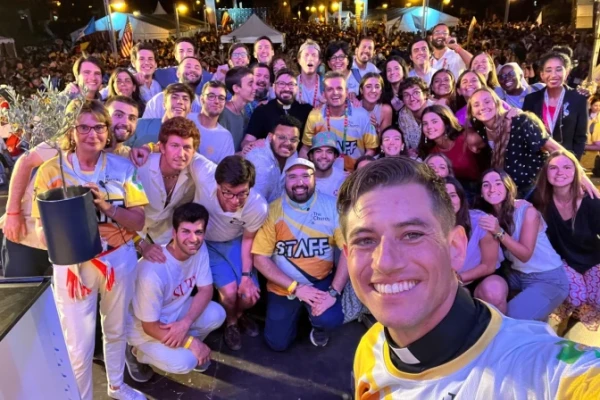
But he said he tries to keep Jesus the focus of his content, even if it is a temptation to do otherwise: “It’s not something you overcome all the time,” he acknowledged. “It’s a struggle.”
García pointed out another potential stumbling block for online influencers, faith-focused or otherwise: the algorithm.
“If you say no, I’m not going to do this, I’m just going to do it differently, without filters, without music, without that, it won’t get through” to reach viewers, he said.
Ruiz, who has become the Vatican’s point person for digital evangelization, acknowledged social media’s limitations too: “The timing, the speed, the simplicity of the language.”
That’s why, the Argentinian priest said, it’s only a “first proclamation” — what St. Paul VI called “pre-evangelization,” or evangelization “at its initial and still incomplete stage.”
In the 1975 apostolic exhortation Evangelii Nuntiandi, Paul VI already identified that the 20th century was “characterized by the mass media or means of social communication, and the first proclamation, catechesis, or the further deepening of faith cannot do without these means.”
The Church’s use of modern means of social communication is not new; it has embraced novel technologies from the printing press to the radio.
Likewise, Ruiz insisted that online evangelization is just the traditional missionary activity of the Church, only now, on the digital continent.
He cited a 2023 report from the Synod on Synodality that said: “It is up to us to reach today’s culture in all spaces where people seek meaning and love, including the spaces they enter through their cellphones and tablets.”
Human experience
In the 2012 CNS interview, Prevost pointed to St. Augustine, one of his sources of spiritual inspiration for advice on spreading the good news. “One of the reasons the ‘Confessions’ [of St. Augustine] continues to be one of the widest-read books in the history of the world is precisely because of Augustine’s insight into human experience,” he said.
“Human experience, [Augustine] says, is precisely where you can find God. And the humanity of Augustine is not something which leads into a kind of personalized, egoistic, it’s-all-about-me-and-only-me world, but quite the opposite.”
Sharing bits of humanity on the internet is what another digital influencer coming to the jubilee event said she tries to do in her work.
Author, speaker, and radio host Katie Prejean McGrady shares snippets of her life as a wife and mom with over 40,000 followers on Instagram.
Catholic influencers get to be like the great missionaries of the Church “in the places and spaces where people are often trying to just dull their senses and be distracted,” she said in an interview with EWTN News.
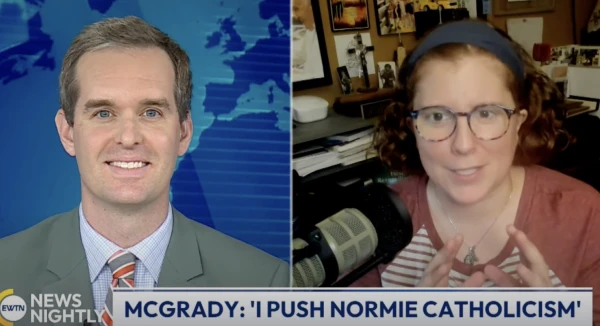
In an email ahead of the Jubilee of Digital Missionaries and Catholic Influencers, McGrady told CNA she hopes “Pope Leo, who isn’t unaware of the digital landscape, strikes an encouraging and hopeful tone in talking about how we go ‘on mission’ into these digital spaces.”
“A pope who is aware of how well (or poorly) these spaces can be used is one, I think, that will be encouraging to those missionaries who are willing to go onto the digital continent and share the Gospel there,” she added.
Pope Leo and Twitter
Leo has plenty of personal experience with social media. He opened a Twitter (now X) account in August 2011, over a year before Benedict XVI earned the moniker of the “tweeting pope” with the launch of the official papal account @Pontifex on Dec. 3, 2012.
Leo XIV’s account, with the handle @drprevost, was deleted within a week of his election to the papacy, but not before other X users had noted and screenshotted a number of the new pope’s replies and reposts, including a criticism of an interpretation of St. Augustine by U.S. Vice President JD Vance.
As a prior general, and later bishop and cardinal, Leo’s over 400 tweets and posts (saved on a webpage) included many reshares of articles from Catholic news accounts, especially with pro-immigrant and pro-life content, information from the Peruvian bishops’ conference, and posts from the Augustinian order.
In fact, the now-pope seemed to have identified social media’s potential early on: One of his first tweets after opening the account was a reply to another user that “the news can be communicated very well here!”
Digital or real?
“In this culture where new generations come with a different way of thinking, where the digital world is real for them… these new places require testimony, witnesses, digital missionaries who are witnesses to the Gospel,” García said.
The priest underlined that the youngest generations are all on social media, so future priests, cardinals — even a future pope — are likely logging on to those platforms too.
That is why, he added, it is important for Pope Leo to be informed: so he can guide the Church in this new challenge.
“I mean, a pope doesn’t come from Mars, and I’ve said it before … the next pope is watching TikTok right now.”
Paola Flynn, Vatican correspondent for EWTN News’ Spanish-language news program, “EWTN Noticias,” and Casey Mann, a summer 2025 intern for EWTN News in Rome, contributed to this report.




